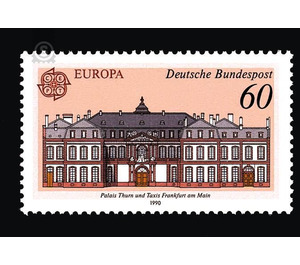Europe - Germany / Federal Republic of Germany 1990 - 60 Pfennig
Theme: Architecture
| Country | Germany / Federal Republic of Germany |
| Issue Date | 1990 |
| Face Value | 60.00 |
| Color | brown |
| Perforation | K 14 |
| Printing Type | Six-color offset printing |
| Stamp Type | Postage stamp |
| Item Type | Stamp |
| Chronological Issue Number | 1334 |
| Chronological Chapter | GER-BRD |
| SID | 277421 |
| In 54 Wishlists | |
The beginning of the Spanish War of Succession brings a fateful time for the house of Thurn and Taxis. At the beginning of 1701 French troops occupied the city of Brussels. Prince Eugen Alexander must give way to the power of arms and move to Frankfurt at the beginning of the year 1702. Only the son, Prince Anselm Franz, the Emperor Karl VI. In 1715 he was entrusted with the Reichspostgeneralat and was able to return to the Brussels residence. Brussels, however, is no longer what it used to be, the center of the postal network, for Thurn und Taxis. So the request was Emperor Charles VI. Certainly welcome to the Prince, who "graciously proclaimed to him what shape her and the whole empire's service required that the imperial general postmaster-general should live in the Reich for the purpose of observing his office." Anselm Franz chooses the already familiar Frankfurt. Already in 1727, the correspondence with the first architect of France, Robert de Cotte, begins about the plans for the new palace. In 1731 it is finally time for the designs of Robert de Cotte to be carried out and construction begun. Guilleaume Hauberat, the pupil and friend of de Cotte, is on September 19, 1731 committed by the Prince as a director of construction. The palace comprised about 140 rooms. We get an idea of the splendor of the court, when we learn from a bill of 1744 that the expenditure for it amounts to more than a quarter of a million gulden. In 1748, Prince Alexander Ferdinand moved to this city as the newly appointed Principal Commissioner of Emperor Franz I at the Reichstag in Regensburg. The palace in Frankfurt has served as a princely residence for less than a decade. On the evening of March 22, 1944, the palace was badly damaged. From the palace itself, today only the two pavilions are on the side of the main portal.


